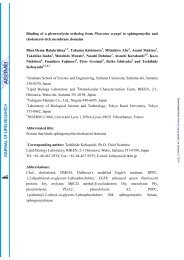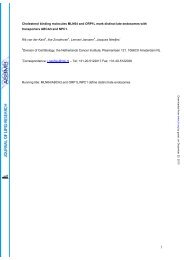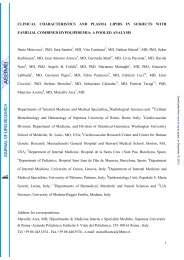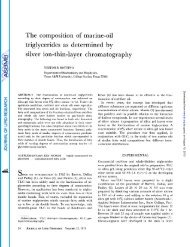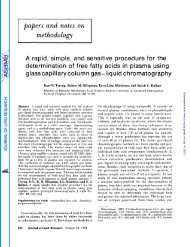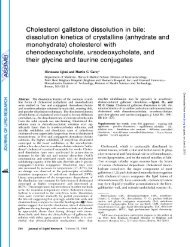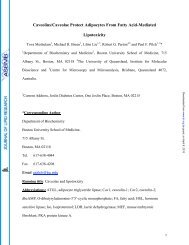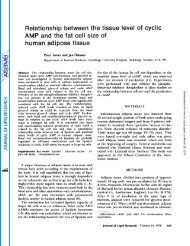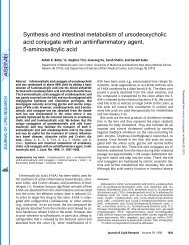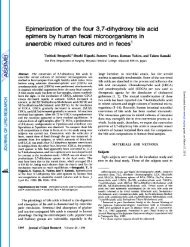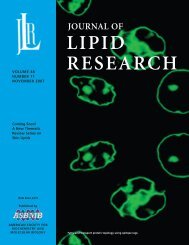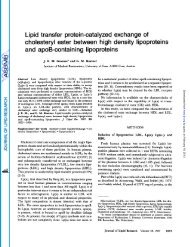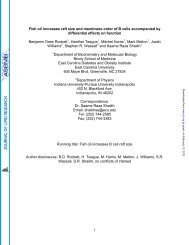a LDL lowering by - The Journal of Lipid Research
a LDL lowering by - The Journal of Lipid Research
a LDL lowering by - The Journal of Lipid Research
Create successful ePaper yourself
Turn your PDF publications into a flip-book with our unique Google optimized e-Paper software.
TABLE 5. <strong>LDL</strong> kinetic parameters <strong>of</strong> guinea pigs fed control, pectin, guar gum, and psyllium diets with low<br />
cholesterol (0.04%. w/w) or high cholesterol (0.25%. w/w)<br />
Diets ApoB Pool Size FCR ApoB Production tes<br />
Low cholesterol<br />
Control<br />
Pectin<br />
Guar gum<br />
Psyllium<br />
19.2 f 5.8 0.073 f 0.005b 1.42 f 0.36<br />
19.7 f 4.2 0.093 f 0.0059 1.70 f 0.53<br />
12.7 It 3.4 0.113 f 0.020. 1.58 f 0.30<br />
19.0 f 5.2 0.103 f 0.0150 1.95 f 0.62<br />
High cholesterol<br />
Control<br />
Pectin<br />
Guar gum<br />
Psyllium<br />
51.8 f 13.e 0.057 f 0.0096 2.81 f 0.50.<br />
32.3 f 13.66 0.078 f 0.0190 2.17 f 0.496<br />
37.3 f 8.7b 0.059 f 0.0166 2.10 It 0.39<br />
26.5 f 2.V 0.080 f 0.010. 2.08 f 0.406<br />
Twmway ANOVA<br />
Fiber effect P = 0.033 P < 0.0001 P = 0.003<br />
Cholesterol effect P < 0.0001 P < 0.0001 P = 0.004<br />
Interaction N.S. N.S. P = 0.01<br />
Values are presented as mean f SD for n - 5-8 animals per dietary group. Values in the same column within<br />
the low or high cholesterol groups with different superscripts are significantly different as determined <strong>by</strong> one-way<br />
ANOVA and the Newman-Keules post hoc test (P < 0.001).<br />
plasma apoB levels was observed for animals fed the<br />
physiological levels <strong>of</strong> dietary cholesterol (LC diets)<br />
while PE, GG, and PSY significantly reduced plasma<br />
apoB concentrations in the HC group, indicating that<br />
fiber reduced not only the amount <strong>of</strong> total cholesterol<br />
but, in addition, the number <strong>of</strong> lipoprotein particles<br />
(Table 2). A fiber effect in reducing plasma apoB concentrations<br />
was detected <strong>by</strong> two-way ANOVA while<br />
increasing the amount <strong>of</strong> dietary cholesterol resulted in<br />
increases in plasma apoB levels, suggesting a higher<br />
number <strong>of</strong> apoB-containing lipoproteins.<br />
Hepatic cholesterol concentrations in both the free<br />
and esterified pools were reduced <strong>by</strong> dietary soluble<br />
fiber (Table 3). For animals fed LC diets, free cholesterol<br />
was reduced an average <strong>of</strong> 20% <strong>by</strong> intake <strong>of</strong> the three<br />
fiber sources while PSY had the most pronounced effect<br />
in <strong>lowering</strong> hepatic esterified cholesterol, followed <strong>by</strong><br />
PE and GG (Table 3).<br />
<strong>The</strong> <strong>lowering</strong> <strong>of</strong> hepatic cholesterol in animals fed HC<br />
diets differed in order <strong>of</strong> magnitude depending on the<br />
fiber source. PE had the most pronounced cholesterol<strong>lowering</strong><br />
effect as it reduced <strong>by</strong> 60 and 95% the free and<br />
esterified hepatic cholesterol pools, respectively; PSY<br />
had an intermediate effect while GG effects were moderate<br />
(Table 3). <strong>The</strong>se differences in hepatic cholesterol<strong>lowering</strong><br />
result from different mechanisms as will be<br />
demonstrated in subsequent experiments. Hepatic cho-<br />
lesterol 7a-hydroxylase was upregulated 3-fold <strong>by</strong> PE<br />
and PSY in animals fed LC diets. PE upregulated the<br />
enzyme activity <strong>by</strong> 5-fold in animals fed HC diets while<br />
the effects <strong>of</strong> PSY on cholesterol 7a-hydroxylase were<br />
more modest. In contrast to PE and PSY, GG intake did<br />
not affect hepatic cholesterol 7a-hydroxylase activity in<br />
either the LC or HC groups (Table 3).<br />
To determine whether the reduction in hepatic cholesterol<br />
concentrations was due to decreased delivery <strong>of</strong><br />
cholesterol to the liver <strong>by</strong> chylomicron remnants, the<br />
effects <strong>of</strong> fiber on cholesterol absorption were measured.<br />
PE reduced cholesterol absorption <strong>by</strong> 40 and 26%<br />
in animals fed both the LC and HC diets, respectively<br />
(Table 4). GG decreased cholesterol absorption <strong>by</strong> 28%<br />
only in animals fed HC diets. PSY did not affect cholesterol<br />
absorption compared to animals fed control diets<br />
in the presence <strong>of</strong> either low or high concentrations <strong>of</strong><br />
dietary cholesterol (Table 4).<br />
<strong>LDL</strong> metabolic parameters were distinctively affected<br />
<strong>by</strong> dietary fiber type. <strong>LDL</strong> fractional catabolic rates<br />
(FCR) were increased <strong>by</strong> PE, GG, and PSY in animals<br />
fed LC diets while there was no effect on <strong>LDL</strong> apoB flux<br />
rates or <strong>LDL</strong> apoB pool size (Table 5). As dietary soluble<br />
fiber reduced plasma cholesterol concentrations and<br />
guinea pigs carry the majority <strong>of</strong> cholesterol in <strong>LDL</strong>,<br />
these data indicate that the number <strong>of</strong> <strong>LDL</strong> particles was<br />
not affected <strong>by</strong> fiber but the size <strong>of</strong> the <strong>LDL</strong> was,<br />
Downloaded from www.jlr.org <strong>by</strong> guest, on August 28, 2013<br />
Dietary fiber and mechanisms <strong>of</strong> plasma <strong>LDL</strong> <strong>lowering</strong> 2399



